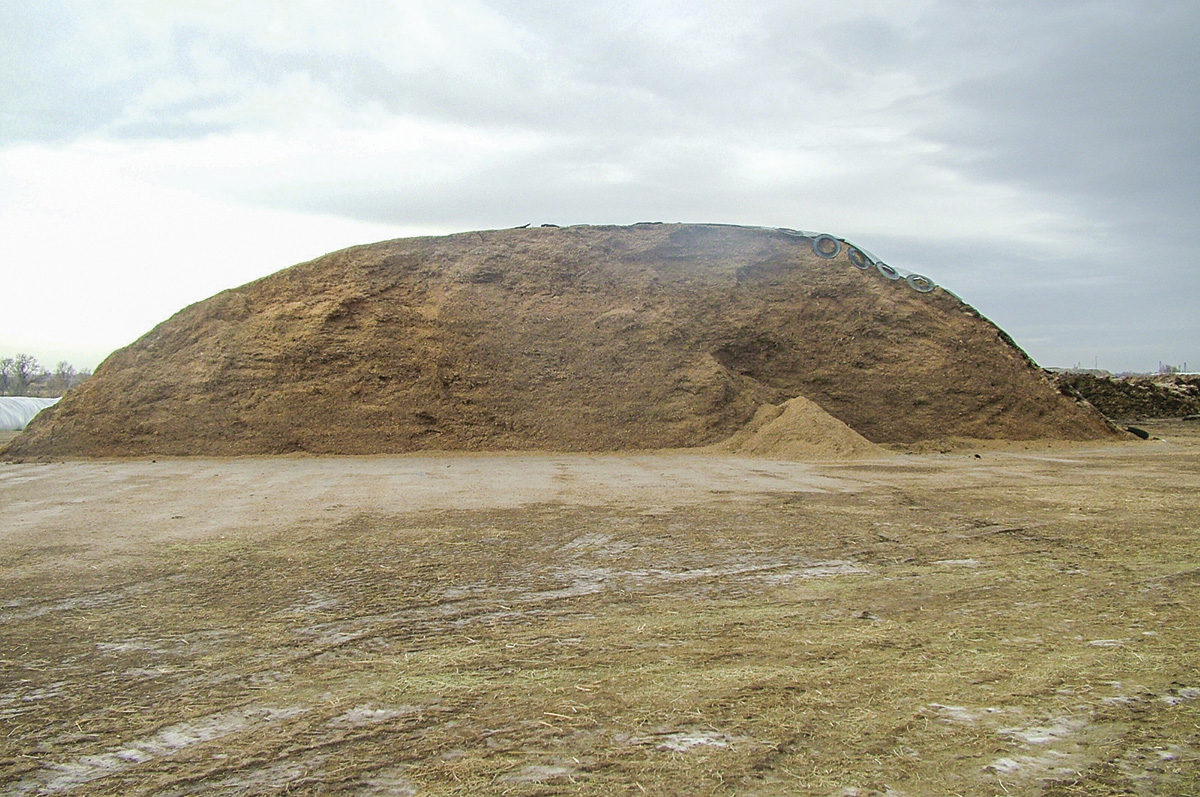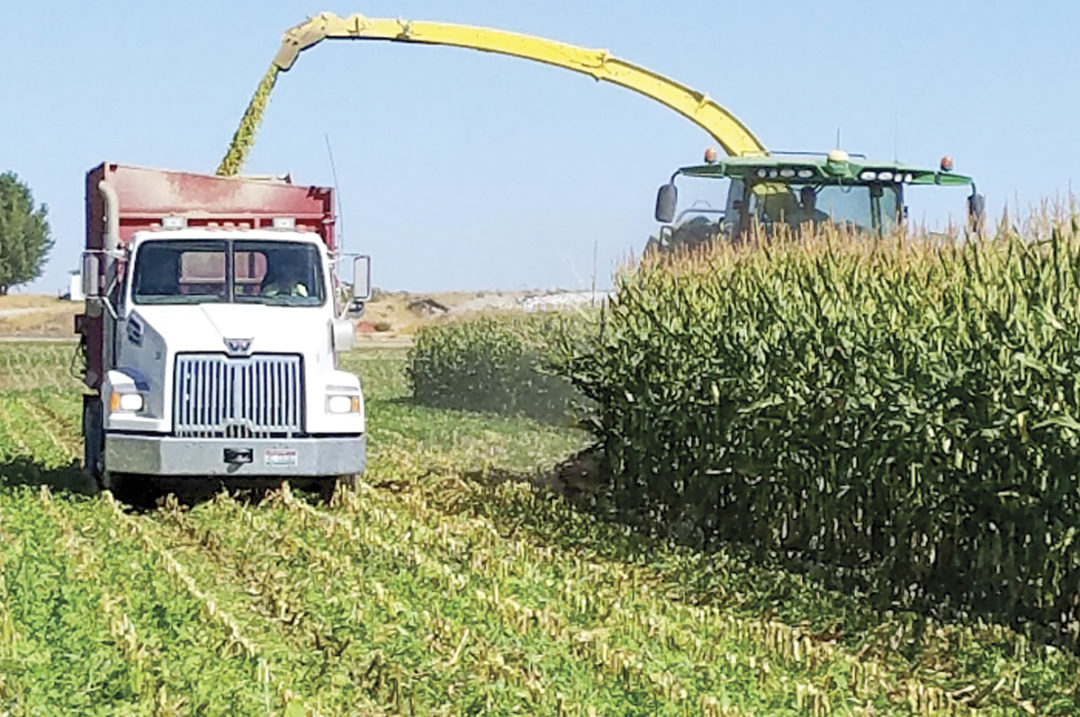Silage is a common feed for dairy cattle and often utilized in beef operations. Silage can be created from nearly any forage crop, including grasses and legumes, but corn is often used because it is the most energy-dense. Putting up a crop as silage is a way to preserve forage quality through fermentation in an anaerobic environment. Bacteria already present on the crop and those introduced later (inoculated) by some people use soluble sugars to produce acids that prevent growth of other detrimental, spoilage-causing microorganisms.
Silage production is a preferred method of feed storage for energy-dense crops like corn and sorghum, and also when haymaking is challenging with a lot of rain. Corn silage is an important feed source in many parts of the country, and sorghum silage is becoming more common in the beef industry. Corn is preferred for dairies because it generally can produce the most energy per acre with less labor. On the other hand, sorghum requires less fertilization and maintenance, and is generally a good choice for low-input systems. The success, product quality and length of storage depend on initial characteristics of the material – soluble carbohydrates, moisture at harvest, chop length and compaction to exclude oxygen.
Silage, especially corn silage, has a lot of nutrient value if harvested and stored correctly, according to Steven Hines, extension educator, University of Idaho Extension in Jerome County.
“If you’ve already been putting up silage, you know the appropriate relative maturity of the corn for your region. If you are new to putting up corn silage, however, talk with your seed company and get a variety that is adapted to your growing season,” Hines says. “If you don’t have your own corn harvesting equipment, contact a custom harvester early in the season to get on their schedule, especially in an area with a lot of dairies where they get scheduled early.”
Choose a good variety of corn for your purposes.
“Some are bred for grain production; stalks tend to be shorter and most of the plant energy goes into ears. Silage varieties tend to be taller [more plant mass] but still put on a good ear. They are bred specifically for silage mass,” Hines says. “There are also dual-purpose varieties, giving you the option of harvesting either way. Talk with your seed company rep to make sure you get the best corn variety for what you want to do.”
Regarding storage, what you do will depend on your facility.
“In the West, we tend to have mostly drive-over piles. In the Midwest and East, most farmers use upright silos. For a drive-over pile, it's best if you have a hard, clean area like concrete or asphalt rather than dirt – which creates some contamination and loss,” Hines says. “If you have a drive-over or bunker-type pile, it needs to be properly covered after the silage is put in, to help minimize dry matter losses. Check with tarping companies in your area to get on their schedule.”
Good silage is put up somewhere in the range of 65% to 70% moisture.

Photo provided by Steve Hines.
“About 68 to 70 percent is considered ideal. Moisture content is crucial for making good silage. Monitor the corn crop to know when it is reaching that level or have someone from your custom harvest company or seed company work with you if you don’t know exactly when that is,” Hines says. “If silage is put up too wet – cut too early – ears have not finished developing and the starch level [energy] is not high enough. Even worse, wet silage tends to produce more undesirable bacteria and bad molds.”
If it is put up too dry, it’s hard to pack adequately.
“It’s too fluffy and doesn’t pack well – and dry matter losses increase because it’s hard to get the pile to ferment properly. You can’t get the air all pushed out. You need proper moisture level at harvest, so it’s crucial to have the harvest company lined up and your storage facility ready to go – so your corn can be put up at the perfect time,” Hines says.
The custom harvest crew will have their own packing crew, but it’s important that silage gets packed tight enough to push all the air out. Hines did a study several years ago, looking at packing density of piles of silage across southern Idaho, and found that most silage was just barely packed enough and, in some cases, not enough.
“Build the pile fast. Ideally, you’d make a pile within just a day or two and immediately get it covered,” Hines says. “You don’t want it exposed to air very long because dry matter losses begin immediately.”
Seal off the top layer to protect it from air and oxidizing and keep off rain or snow.
“A rule of thumb for corn silage is that it should sit for at least three or four months for the fermentation process to be fully complete before you break into it and start feeding. We call it a Christmas feed because it takes about that long from harvest to be ready to feed. Some people start feeding a little sooner because they need the feed, but it’s better to wait a bit,” Hines explains. “Most of the literature says four months. The longer it can sit, the better it will be. It will fully ferment and become stable at about six months, though it will be good silage by four months.”
It will keep several years, once properly fermented and protected. It doesn’t lose quality; silage keeps its nutrient quality longer than baled hay.
When you start to feed a pile, do it strategically because once you open it up, the quality starts to deteriorate.
“Manage the face of the pile so the exposed surface is used daily. When you build the pile, make it proper size so you can feed material from across the entire open face each day,” Hines says.
Then what you feed the next day is relatively new; you don’t have some that’s exposed to the air a long time.
“Feed off about 6 inches of that entire face each day to stay ahead of oxygen’s effect. It’s like opening a loaf of bread. Once you open it, oxygen starts into the bread and it begins to get stale. As oxygen penetrates into the pile, it also reinvigorates the aerobic organisms and they start digesting the energy components of the feed, and you lose dry matter,” Hines says. “Those microbes are eating your silage and reducing nutrient quality. Then you have to feed more to your cows to get the same energy, since you’ve lost some.”
“Even if you do everything correctly, however, you’ll still have about 10 percent dry matter loss. If a pile has 1,000 tons of corn silage, you’ve lost 100 tons. That’s a lot of money lost – from the time the ground was worked until the pile was covered,” Hines says. “If you haven’t put up silage before, you need to not only figure out how many tons of silage you think you’ll need, but also add some additional acres to make up for that dry matter loss.”











